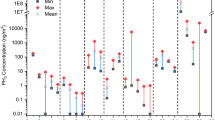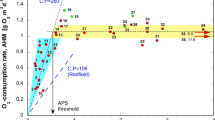Abstract
The role of phosphorus in limiting organic matter production and in causing eutrophication has been in the forefront of hydrobiological research during the past 30–50 yr1–7. Comparing the cycles of major biogenic elements, it is evident that, with the exception of phosphorus, each of them contains gaseous substances (for example, CO2, CH4, O2, N2, NH3, H2S and volatile organic sulphur compounds) which, because of their gaseous state, can leave aquatic systems8–16. We examined the phosphorus cycle of open-air sewage treatment plants and a deficit (∼30–45%) in the phosphorus mass balance was found which cannot be explained by knowledge based on earlier research on this cycle of the hydrosphere. By developing special sampling and analytical methods, we have shown that gases released from the sewage treatment plants and from the sediments of shallow (1–2 m deep) waters contain a reduced, gaseous phosphorus compound: phosphine. According to our measurements and calculations, about 5g of phosphorus per day was released as phosphine from an Imhoff tank settling 2,000 m3 per day of raw sewage. Under laboratory conditions, it was also demonstrated that phosphine is released by bacterial reduction from a medium containing inorganic phosphorus. The phosphorus content of the medium decreases by nearly one half. Our results on the metabolic importance of phosphine formation and release suggest that ∼25–50% of the phosphorus deficit in open-air sewage treatment plants can be explained by the release of phosphine into the atmosphere. These results change our understanding of the aquatic phosphorus cycle; former ideas about the phosphorus budget should be revised.
This is a preview of subscription content, access via your institution
Access options
Subscribe to this journal
Receive 51 print issues and online access
$199.00 per year
only $3.90 per issue
Buy this article
- Purchase on Springer Link
- Instant access to full article PDF
Prices may be subject to local taxes which are calculated during checkout
Similar content being viewed by others
References
Sawyer, C. N. Sewage ind. Wastes, 24, 768–776 (1952).
Ohle, W. Vom Wasser 20, 11–23 (1953).
Lund, J. W. Nature 214, 557–558 (1967).
Thomas, E. A. Mitt. int. Verein. theor. angew. Limnol. 14, 231–242 (1968).
Thomas, E. A., Wass. u, Energ. Wirt. 60, 115–125 (1968).
Edmondson, W. T. Science, Wash. 169, 690–691 (1970).
Vollenweider, R. A. & Dillon, P. J. The Application of the Phosphorus Loading Concept to Eutrophication Research (Nat. Res. Council of Canada, Ottawa, 1974).
Hutchinson, G. E. A Treatise on Limnology I (Wiley, New York, 1957).
Reid, G. K. Ecology of Inland Waters and Estuaries (Van Nostrand, New York, 1961).
Dussart, B. Limnologie (Gauthier-Villars, Paris, 1966).
Wetzel, R. G. Limnology (Saunders, Philadelphia, 1975).
Svensson, B. H. & Söderlund, R. (eds) Nitrogen, Phosphorus and Sulphur - Global Cycles. SCOPE Report 7. Ecol. Bull., Stockholm, 22, 1–192 (1976).
Emsley, J. in The Handbook of Environmental Chemistry Vol. 1, Part A (ed. Hutzinger, O.) 147–167 (Springer, Berlin, 1980).
Golterman, H. L. & Kouwe, F. A. in The Functioning of Freshwater Ecosystems IBP 22 (eds Le Cren, E. D. & Lowe-McConnell, R. H.) 85–140 (Cambridge University Press, 1980).
Moss, B. Ecology of Fresh Waters (Blackwell Scientific, Oxford, 1980).
Uhlmann, D. Hydrobiologie (Gustav Fischer, Jena, 1982).
Dévai, I. Acta Biol. Debrecina 14, 51–65 (1977).
Dévai, I. Acta Biol. Debrecina 14, 67–78 (1977).
Dévai, I. & Woynarovich, E. in Some Approaches to Saprobiological Problems (ed. Sudzuki, M.) 37–47 (Sanseido, Tokyo, 1981).
Dévai, I. et al. Envir. Pollut. B8, 155–160 (1984).
Dévai, I., Dévai, Gy. & Wittner, I. Arch. Hydrobiol. Monogr. Beiträge 4, 534–579 (1985).
Heim, Cs., Dévai, I. & Harangi, J. J. Chromatogr. 295, 259–263 (1984).
Gmelins Handbuch der anorganischen Chemie. Phosphor. Part C (Verlag Chemie, Weinheim, 1965).
Stumm, W. & Morgan, J. J. Aquatic Chemistry. An Introduction Emphasizing Chemical Equilibria in Natural Waters (Wiley-lnterscience, New York, 1970).
David, R. Radiat. Environ. Biophys. 25, 219–229 (1986).
Iverson, W. P., Olson, G. J. & Heverly, L. F. in Biologically Induced Corrosion (ed. Dexter, S. C.) 154–161 (Natn. Assoc. of Corrosion Engineers, Houston, Texas, 1985).
Dévai, I. Acta Biol. Debrecina (in the press).
Murphy, J. & Riley, J. P. Analytica Chim. Acta 27, 31–36 (1962).
Gales, M. E., Julian, E. C. & Kroner, R. C. J. Am. Wat. Wks Ass. 58, 1363–1368 (1966).
Horváth, I. Mechanical Waste Treatment VIZDOK (Budapest, 1973).
McNair, H. M. & Bonelli, E. J. Basic Gas Chromatography (Consolidated Printers, Berkeley, California, 1969).
Rheinheimer, G. Mikrobiologie der Gewässer (Gustav Fischer, Jena, 1971).
Daubner, I. Mikrobiologie des Wassers (Akademie, Berlin, 1972).
Rodina, A. G. Methods in Aquatic Microbiology (University Park Press, Baltimore, 1972).
Gorlenko, V. M., Dubinina, G. A. & Kuznetsov, S. I. The Ecology of Aquatic Micro-organisms (E. Schweizerbart, Stuttgart, 1983).
Tóth, L. Res. Water Quality Technol., Budapest 2, 48–55 (1972).
Kov´cs, M. & Tóth, L. Proc. VITUKI, Budapest 14, 49–74 (1979).
Dévai, Gy. in Chironomidae (ed. Murray, D. A.) 269–273 (Pergamon, Oxford, 1980).
Bossard, A., Kamga, R. & Raulin, F. J. Chromatogr. 330, 400–402 (1985).
Hashimoto, S., Fujiwara, K. & Fuwa, K. Analyt. Chem. 57, 1305–1309 (1985).
Author information
Authors and Affiliations
Rights and permissions
About this article
Cite this article
Dévai, I., Felföldy, L., Wittner, I. et al. Detection of phosphine: new aspects of the phosphorus cycle in the hydrosphere. Nature 333, 343–345 (1988). https://doi.org/10.1038/333343a0
Received:
Accepted:
Issue Date:
DOI: https://doi.org/10.1038/333343a0
This article is cited by
-
Routes to reduction of phosphate by high-energy events
Communications Earth & Environment (2023)
-
Plausible Emergence and Self Assembly of a Primitive Phospholipid from Reduced Phosphorus on the Primordial Earth
Origins of Life and Evolution of Biospheres (2021)
-
Global phosphorus dynamics in terms of phosphine
npj Climate and Atmospheric Science (2020)
-
Research progress and application prospect of anaerobic biological phosphorus removal
Applied Microbiology and Biotechnology (2019)
-
A Novel Biocontainment Strategy Makes Bacterial Growth and Survival Dependent on Phosphite
Scientific Reports (2017)
Comments
By submitting a comment you agree to abide by our Terms and Community Guidelines. If you find something abusive or that does not comply with our terms or guidelines please flag it as inappropriate.



